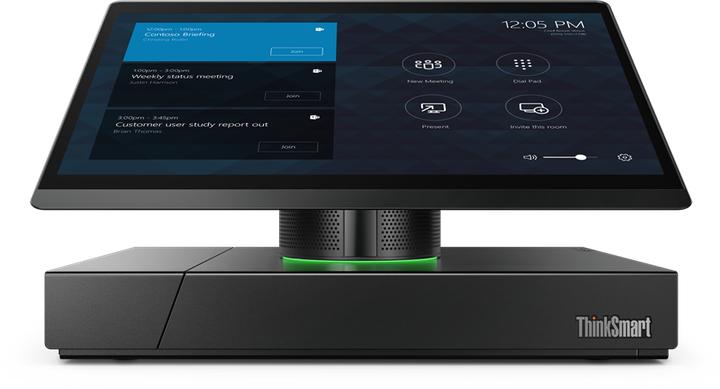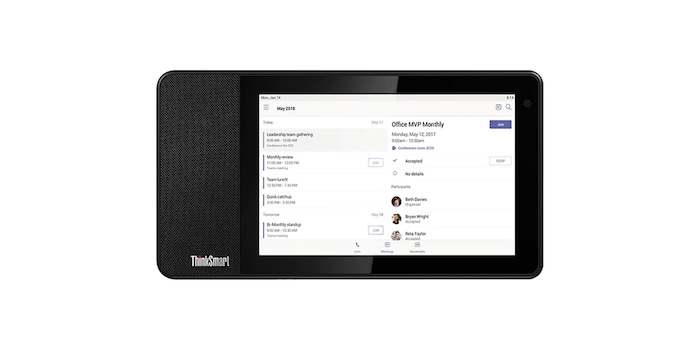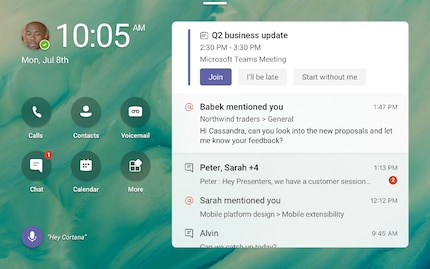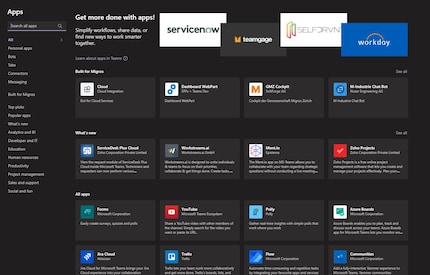

The Microsoft Teams tablet: the hunt for lost seconds
Lenovo's ThinkSmart may look silly and its concept seems far-fetched, but clearly Microsoft and Lenovo are well aware that time is money.
Indispensable IT giant Microsoft has teamed up with old hand Lenovo to dream up, design and market a device straight out of the 1990s. The Lenovo ThinkSmart View is a kind of tablet that does nothing but display Microsoft Teams.
And Cortana too. In other words, a device that your boss puts on your desk and forces you to use because you don't respond to his stupid Teams messages efficiently and quickly enough.
See you later.
Thank you, Microsoft. Thank you, Lenovo.
Despite all the existential horror this device embodies, it demonstrates the full potential of Android. It gives an insight into pricing policy in the B2B segment and highlights an element often underestimated by businesses: the cost of time.
The tablet that isn't
The Lenovo ThinkSmart View is a tablet of sorts running on AOSP 8.1, software dating back to 2017. Its range although smaller is similar to that of a tablet. That's precisely what makes this device as ridiculous as it is interesting. Because Android is not, as is often assumed, software that must always be able to do everything, but a modular structure. That's why Android on smartphones and tablets still feels a little unfinished. Android isn't an operating system, it's a platform.

Removing features and applications allows you, as a developer, to use less capable hardware. So the ThinkSmart is powered by a Qualcomm Snapdragon 624 system-on-chip, a SoC from 2018.
The strange pricing policy of B2B
The lower performance of hardware and the age of software could have an impact on prices. Indeed, if you only want to support one app, or even two, and save on hardware, the device will never cost as much as a high-end smartphone.
Unless your name is Lenovo. Then the ThinkSmart View will cost you about as much as two tablets you'd use at home, in the living room or in the loo. That's because the ThinkSmart View isn't designed for end users. It's designed for businesses, which automatically pushes up the price. If you're part of a multi-billion-dollar company, a few thousand francs is negligible. Even less so if the time saved is at least equal to the investment in ThinkSmart.

Many companies make a mistake here: employees' time costs them money. Saying "there's just more clicking here and there" is an argument that doesn't hold water in a modern business. Many of these actions (a click here, an email there) are not even worthy of a trainee during their first week, even less so when they are part of the normal work process. After all, a trainee also has skills and a value that goes far beyond a few absurd clicks.
More concretely: a commercial employee in Zurich earns 5634 francs a month, which, over a 42-hour week, gives a gross salary of 33.53 francs an hour. We can deduce from this that a company rewards not only an employee's performance, but above all their time. The time the employee spends working. It sounds very simple when you put it like that, but it helps us to understand why it is in the company's interest for a worker to use that time as efficiently and productively as possible. Remuneration for performance comes later in the form of bonuses.
In other words, the more efficient and optimised daily work is, the more can be done during that time, the more overtime can be avoided and the more money a company saves. Even if it means using a slim, slow tablet that performs a specific function in a targeted way. In Lenovo's case, communication is made easy. The thought process results in the time saving that saves money.
In a company's theoretical calculation, it doesn't take much to justify the relatively high price of a ThinkSmart. A business decision-maker only needs to see a time saving of around 10 hours to make the CHF300 price tag for a device like the Team Tablet worthwhile. Add a few hours of running-in and training, and you're looking at a saving of around 20 hours. The more efficient employee has already recouped the cost of the ThinkSmart.
This reasoning explains the presence of ThinkSmart View on your desk. If a meeting has to be held on Teams or Zoom, it's not just one person's time that's at stake, but that of all the participants. So each minute costs not just 55 centimes, as it does for a shop assistant, but much more when managers are involved. That's easily 1.50 francs a minute. Unfortunately, executive salaries are difficult to determine without resorting to wild fantasies, which is why I've assumed a threefold increase in the number of employees, which I consider to be a very conservative estimate. According to my calculations, ThinkSmart View can be justified after just 3 hours 20 minutes of time saving. Beyond that, the 300 CHF for the tablet has already paid for itself.
In the context of a company churning out billions, a ThinkSmart View is therefore not too expensive.
Teams: Skype made better
The hardware, which costs CHF300 excluding VAT, primarily offers Microsoft Teams, the successor to Skype. The mistake is that Teams is too often used like Skype. A little chat here, a little telephony there.
Going against the grain of users, Microsoft engineers are working to make the software as efficient as possible. There are interfaces to all the main planning tools, such as Atlasian's Jira for programmers or Adobe's Creative Cloud. The functionality of these efficiency-enhancing tools can be integrated into Teams. This means you can receive notifications when another department in your company has completed a task, so they don't have to write: "Dear colleague, thank you for your valuable feedback. You also avoid nightmare processes like: "Write to Michelle in accounts again, except on Tuesday, because I think she's at handball in the afternoon. In that case, contact Tom. Except that Tom's on holiday, so it's probably Andrea you should be writing to. Well, ask the boss who's in charge at the moment."

When the job is done, Teams sends the necessary notifications to the relevant users, and that's that. In short: Microsoft Teams can be very fast if configured correctly. It has to be said that the programme has no shortage of APIs. Even company-specific programmes can be integrated. At digitec, we've integrated a Migros gizmo. Incidentally, I haven't learned any more about it in all the time I've been working here.
This also explains the wide distribution of the big videoconferencing competitor Zoom, which is not only free, but also transposes the ThinkSmart View hardware philosophy to software. Zoom is something of the opposite of Teams. Virtually no features or configuration options, no integration options, but user-friendly and quickly deployable. It saves time and energy.
This is also the argument in favour of ThinkSmart Views. It saves time by offering just one function, or even two. On the other hand, the latter is targeted and more effective than the best solution used until now. A device like ThinkSmart View avoids problems. It's a tool with a single function, not something you use every day in your living room. Assuming Teams and your company's other software is set up properly and processes are automated correctly, the living room will be just the place where you can spend more time.
Journalist. Author. Hacker. A storyteller searching for boundaries, secrets and taboos – putting the world to paper. Not because I can but because I can’t not.
From the latest iPhone to the return of 80s fashion. The editorial team will help you make sense of it all.
Show all